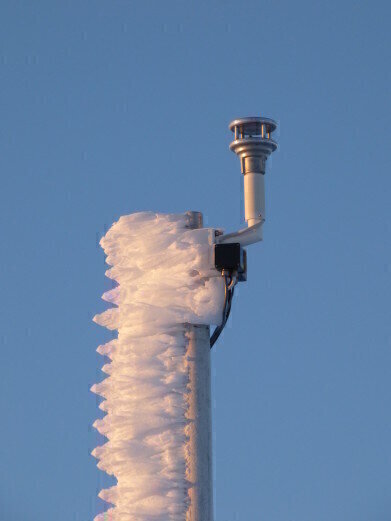Air Monitoring
New Wind Sensor for Extreme Applications
Jul 21 2017
Since January 2016, the Norwegian airport systems integrator Avinor has tested a new Lufft wind sensor model with an enhanced heating power of 240W. Two of the new models are in the field, installed at the most extreme sites in Norway: One is placed at the top of Kjølen mountain, close to Tromsø Airport, at a height of 2,600ft. Here the average winter temperature is minus five degrees Celsius. The other one is mounted at the top of Rustadfjell mountain in a height of 1,100ft close to Bardufoss Airport. This site commonly experiences temperatures of minus ten degrees Celsius in January.
Both locations are very windy and experience numerous snow showers in winter. However, the two VENTUS-X models deliver reliable wind data ever since the installation: “The new sensors are much improved and stability is now as good as our users could wish,” confirmed Avinor system manager Sander Bjørn Hansen.
The successful test in Norway represents the starting point of the VENTUS-X product launch.
The robust and maintenance-free wind sensor is designed for professional meteorological applications in all climate zones. Therefore, besides airport applications, it’s especially suitable for meteorological services, marinas and ships. Moreover, it can be applied on wind turbines, traffic control systems, in avalanche as well as flood warning stations or as component of hydro-meteorological monitoring stations in general. The stainless housing makes it appropriate to be installed in coastal regions. This stability is owed both to the rugged housing as well to its sophisticated measurement principle.
VENTUS-X detects wind speed, wind direction, virtual temperature as well as barometric pressure. The ultrasonic wind sensor uses the run-time differential method for determining the wind speed and wind direction. It provides output for instantaneous values, vector and scalar means, the maximum gust of wind and wind direction, the maximum and minimum values and the virtual temperature.
Data output through serial or analogue interfaces provides compatibility of the Lufft VENTUS for commercially available hydro-meteorological dataloggers and PLC systems. Available interfaces SDI-12, RS-485, various RS-485-protocols as well as an analogue output.
An integrated, strong transducer heater keeps it free of ice even in extreme cold conditions. The closed metal housing provides a maintenance-free operation. Its casing material is also applied for ship propellers and proved itself as extremely rugged.
The VENTUS-X was successfully tested and certified for extreme ambient conditions: Official institutions, such as TÜV SÜD, verified it in terms of temperature, air humidity, electromagnetic compatibility, vibration, salt spray, icing and wind strengths.
Digital Edition
IET 34.2 March 2024
April 2024
Gas Detection - Biogas batch fermentation system for laboratory use with automatic gas analysis in real time Water/Wastewater - Upcycling sensors for sustainable nature management - Prist...
View all digital editions
Events
Apr 30 2024 Melbourne, Australia
Apr 30 2024 Birmingham, UK
May 03 2024 Seoul, South Korea
May 05 2024 Seville, Spain
May 06 2024 Minneapolis, MN, USA


















